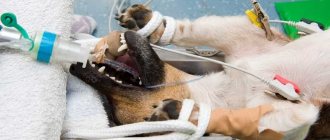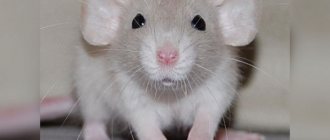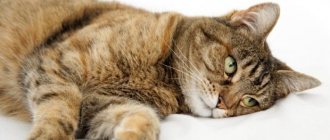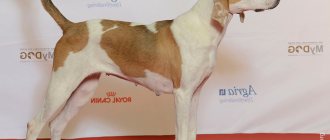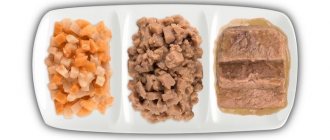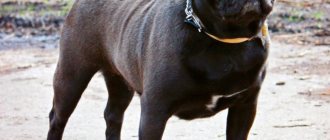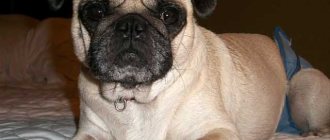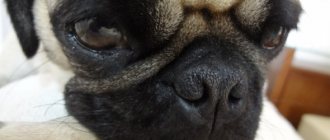What should be the correct ear shape for pugs?
Experienced “pug breeders” know that dogs of this breed have three main ear shapes:
- "Button" . In this case, the ears are bent so that the ear canal is completely invisible.
- "Rose" . In this case, the ear is “broken” approximately in the middle of the auricle, making the ear canal partially visible.
- "False Rose" . In this case, the ear is “broken off” almost at the first 1/3 of the length of the auricle, which is why the entire ear canal is immediately visible.
Let us immediately note that ideally the animal should have a “push-button” shape of ears. "Rose" is also acceptable, but not very desirable. The third option is completely unacceptable. In any case, for those animals that will be used for breeding purposes and/or will participate in exhibitions.
Thus, ear taping is an event whose purpose is to give the ears an ideal shape. Again, we’ll immediately warn you that this does not help all animals and not always (but we’ll talk about this below).
How long to glue ears
The final formation of the ear cartilage in a pug ends at about one and a half years, so it is before this age that the owner of a pet of this breed has a real opportunity to give the dog’s outer ears the most correct and very practical shape.
The duration of measures to correct the shape of a pug’s ears can vary quite a lot. The later the first fixation of the ear cartilage in the correct position is carried out, the longer the entire correction process takes. Most often, the adhesive plaster falls off on its own after about ten days, after which the ears are allowed to rest for a day and the gluing process must be repeated.
This is interesting! If your pet's ears do not take the correct shape for too long, then experts recommend using special fertilizers that strengthen cartilage tissue and joints.
The most affordable and very effective drugs include the well-proven and popular among dog breeders Canina Artro Tabletten + Canina GAG, as well as Rolidex Gelabon Plus and Canipur “Calcigel”.
Return to content
What you need to glue your ears
To “glue” dog ears you will need to buy:
- The patch is no more than one centimeter wide. We recommend using a regular patch. Bactericidal varieties may cause allergic reactions. If a particular animal is particularly sensitive to the skin of the ears, it is better to buy a patch approved for the treatment of small children. It has a hypoallergenic base and is much easier to remove after use.
- Since the formation of cartilage tissue is greatly influenced by the content of macroelements in the food (especially calcium), we recommend using multivitamin preparations during the period of gluing the ears (of course, after prior consultation with a veterinarian). Such means can significantly speed up obtaining the desired result.
- In addition, the owner needs to be patient, since the formation of the desired shape of the auricle is not a very fast process.
How can you tell if your pug is sick?
Dog owners, even those who just recently got a pet, always wonder: how to understand that a pug is sick, how to quickly recognize the disease if you have never encountered anything like this before.
Doctors say that the owner needs to independently monitor the animal, study habits and habits, monitor activity and proper nutrition. Just like in humans, signs of the disease are immediately visible in animals. Usually this is lethargy, reluctance to drink and eat, negative emotions when trying to play. It is usually clear from animals that health problems have arisen. In pugs, many diseases are manifested by difficult breathing and elevated temperature. The dog lies all the time and is not active.
If we say that a pug is experiencing an allergic reaction, the symptoms may not be noticeable at first and accumulate over time. In any case, you should not use traditional methods and self-medicate.
The owner needs to independently monitor the animal, study habits and habits
When to glue your ears and when it's useless
Ears need to be glued starting from puppyhood. More precisely, starting from three or four months, since it is at this time that the density and rigidity of the cartilage of the auricles begins to increase. This process (depending on the nutritional characteristics and characteristics of the animal) can last up to one and a half years (but usually ends at one year of age).
There is a sense in gluing, starting from the age of four months and up to one and a half years.
If the dog is much older, it is practically useless to glue his ears - it is a waste of time, they will probably never acquire the correct shape. Some dogs have the correct ear shape from the start, and in such cases there is no need to correct it. On the contrary, in other animals the ears are so “obstinate” that even long-term fixation of them does not help. However, it should be noted that in most cases gluing gives a positive result. You just need to be patient!
Examination, care, cleaning of ears
A flat muzzle, a relatively damp head, folds and other breed characteristics affect the health of a pug’s ears. Therefore, you need to inspect them daily, paying attention to any changes:
- there is more sulfur
- bad smell
- liquid discharge
- redness
- scratches, rash
- swollen skin
Any of the symptoms is a reason to consult a veterinarian. If all is well, basic care is enough. Every day before going to bed, wipe the fabric from the inside with a special liquid, miramistin, chlorhexidine or warm water if there is little discharge.
Be sure to do it after a walk, since you can’t go out with damp ears - the slightest hypothermia provokes otitis media.
The ear canal is cleaned weekly with gauze pad. There is no need to climb deeply - only the visible part. Heavy discharge is softened by dripping a special lotion. Head shaking immediately after brushing is normal. If this happens more and more often, you need to see a doctor.
Share how important the shape of your pet's ears is to you. Did the adjustment by gluing help, if you have such experience?
Method of gluing ears
There is nothing complicated about the gluing itself. The ear needs to be folded along its longitudinal axis (to form two equal triangles). In this position, the shell is fixed with a plaster, placing it as close as possible to the base of the ear. The patch must be applied tightly enough, but not tightly, as otherwise the animal’s blood circulation in the tissues of the auricle may be impaired.
The patch is left in this position for about two weeks. After a two-day break, it is pasted on again. This will take a long time: some dogs have to have their ears glued until they are two years old.
Helpful advice. In order not to torment the dog by tearing off the two-week patch from his ears, you need to apply any greasy cosmetic cream to the bandage half an hour before removing it. The patch will soften and will be much easier to remove. Of course, before applying a new patch, the skin of the ear must be thoroughly degreased using alcohol.
Allergic reactions in this breed
Pugs are prone to allergic reactions, and a large number of owners of this breed of dog at least once encounter this problem.
The causes of allergic reactions are of the following types:
- Food.
- Ecological.
- Chemical.
Food allergies can occur due to the use of the following products: chocolate, eggs, various sweets.
Important! Veterinarians do not recommend giving chocolate and other weaknesses to animals, regardless of breed.
Environmental problems may arise due to the area of residence. Allergies can occur due to certain plants or due to a nearby factory that releases various chemicals into the air.
Allergic reaction in a pug
Chemical reactions often occur due to flea collars, vaccines, sprays, shampoos, vitamin supplements, hygiene products, or as a reaction to taking antibiotics. Pugs are most likely to have food allergies.
Sometimes allergic reactions can cause severe itching in the pug's ears. This may be due to a flea or tick allergy. Sometimes insects can penetrate very deep into the ear and can only be removed with an ear stick. If you cannot penetrate deeply and eliminate the insect, you should immediately consult a doctor. Ignoring such cases can lead to the death of your pet.
You can read more about allergies in dogs
Ear care
You need to take care of your pug's ears regularly. To do this, use various cleansers that need to be used to wipe the ear or regular wet wipes. To eliminate bacteria or severe contamination, you can use ear drops (“Bars”).
In practice, this procedure looks like this:
- Initially, you need to remove the wax with a cotton pad or swab. Do not push the stick deep into the ear to avoid damage.
- Gently clean out all the inner folds with a new ear stick.
- If there is a lot of sulfur, wipe the surface with Vaseline oil and repeat cleaning after 10-20 minutes.
- If purulent discharge or an unpleasant odor is noticeable from the ear, go to the vet immediately.
You can watch the video on how to clean your ears and what proper care should be.
Video - About the pug breed
How to glue ears correctly
A pug's ears begin to break during the period of teeth change. Both “buttons” and “roses” fully comply with breed standards, but “buttons” are more preferable from an aesthetic point of view. The head of an animal with this shape of ears looks rounder and more beautiful.
To give your pet's ears the desired shape, they are glued together. For this procedure you will need a regular patch. Two narrow strips 10-15 cm long fix the desired shape of the ear (see the photo for how this is done).
The adhesive plaster will come off on its own, no need to remove it yourself. The ears will not take the shape of “buttons” immediately; after the first 1-10 days they will break again, and the operation will have to be repeated. There are cases when you have to resort to this practice until the pet is one and a half years old.
Pug and Chinese Crested mix
To create unusual dogs, different breeds are crossed. This breeding method was also used for pug varieties. For example, it was crossed with the Chinese Crested Dog. The result, as expected, was quite unusual. In general terms, the new representative looks like this: bald, in some areas of the body there is fur (tufts), and the skin in some places is very reminiscent of sandpaper.
Interesting stories about the breed
Often, owners of unusual pets post photos of their pets on the Internet, or even create accounts with their name. Such pages on social networks are gaining popularity, and the animal becomes a universal favorite of the public.
The owner wrote about the dog, a cross between a pug and a Chinese Crested, on the Internet, where she talked about interesting things about her friend Boris.
Despite his rather unusual appearance, people fell in love with the pet. As the owner herself writes, she did not expect such a positive reaction in the comments. He loves pickles and a variety of vegetables. Therefore, for his addictions, the owner calls her pet a room gremlin and a “phytops.” The girl admits that at first she was afraid to approach him for about a month. But now it is a favorite of the whole family.
What vaccinations are needed and when to do them?
To prevent the development of many infections in a dog, it needs to receive preventive vaccinations. Before the first vaccination, walking the pug is strictly prohibited. A week before vaccination, complete deworming is carried out.
At two months of age the puppy receives its first vaccination . The second time vaccination is carried out 3 weeks before the change of baby teeth begins.
NOTE!
Veterinarians recommend using complex polyvalent serums for these purposes.
The veterinary clinic must immediately open a passport for the dog, which includes the date of vaccination and the drug used.
You can walk the puppy only after the second vaccination, after a week and a half.
Dangerous insects
During a walk in the summer, insects can easily get into a pug's ears. Is your pug scratching its ears and shaking its head vigorously? Quickly examine the animal. If there is an insect in the ear, it needs to be removed. The insect will not get inside the ear; it will remain in the external auditory canal, from where it can be easily removed. Place the oil in the ear and place the pet on its side; the insect will float to the surface. Now it is easy to remove it with a regular cotton swab. If an insect has crawled deep into the ear, then it is better not to try to pull it out; you will harm the dog by pushing the “alien” deeper. Contact your veterinarian.
How often should you bathe and how to do it correctly?
Bathing should not be frequent; it is enough to do it once every 2-3 months . After each walk, the dog should be wiped with a damp cloth.
When bathing, use a special shampoo. This is especially important for pugs with black fur, as it is more likely to fade and lose its attractiveness.
Anti-flea shampoo is used periodically to prevent parasites.
After bathing, the dog is well dried and wrapped; there should be no drafts in the room.
Necessary materials
What you will need to perform ear surgery at home:
- A thin medical fabric plaster with a width of 10 mm to 1 cm. An adhesive plaster with bactericidal impregnation is not recommended, since the skin near the ears is very sensitive, and pugs often experience irritation and redness from them. It is advisable to opt for a “breathable” and hypoallergenic option: they are easily tolerated by dogs and do not irritate the skin;
- Caring for your pet, accuracy when performing actions and patience. Everything may take longer than originally planned.
It is recommended to carry out the first gluing of the ear cartilage under the supervision of a veterinarian or entrust the complete cosmetic procedure to a professional.
Walk
You can walk your dog only after all stages of vaccination and quarantine. Start with 15 minutes 4-5 times a day. Gradually increase the walking time (30-40 minutes), and reduce the number to two times.
Pugs have short hair, so they need clothing for the pet during the cold season. For winter - insulated overalls. In wet weather, the suit should be waterproof.
Dogs cannot tolerate heat. Therefore, in summer it is better to walk in the morning and evening, when the sun is not so active.
This breed does not require much physical activity. A few laps around the house on a leash is enough. You can play once a week. Pugs don't mind balls or frisbees. Monitor the behavior of teenage dogs. Excessive activity during this period can negatively affect their health.
Choose your walking location carefully. Pugs are domestic dogs and their sense of self-preservation is less developed. Tall grass and branches can damage your eyes.
To prevent your pet from picking up unnecessary things from the ground, it is better to put a muzzle on it.
In the warm season, after going outside, inspect your pet for ticks. Especially the folds on the muzzle.
Dog Breeds Similar to Pugs
There are breeds that look like pugs to many people.
Dogs that can be easily confused with a pug:
- English Mastiff. Dogs are similar to the pug by the presence of folds on the forehead, similar structure and size, as well as coat color.
- French Bulldog. Externally, these two breeds are very similar, and they are easily confused by a non-specialist.
- Pekingese. The Pekingese is similar to a pug, short in stature, short legs and slightly flattened face.
Still unsure about choosing the breed of your future friend? Let's compare the pug with other dog breeds, find out the pros and cons of the breed .
Advantages and disadvantages of pugs:
Pros:
- The average size.
The fairly compact growth of this breed is a significant plus. Pugs may not be as compact as Chihuahuas or Toy Terriers, but they are less of a hassle to care for.
- Good-natured character.
Loyal to their master until the end of their days. Get along with other pets easily. They love children, will play with them with pleasure and will become their protectors. Dogs are usually good-natured and cheerful.
- Easy to care for.
The coat is coarse and short, making it easy to care for. It does not get tangled, does not get tangled, and is relatively easy to clean from various debris and dirt. Dogs do not need to be cut because their hair is short. If desired, it is easy to train your pet to go to the litter box from time to time.
- Not picky about food.
The breed's diet can consist of both dry food and natural ingredients.
Minuses:
- Snore.
Pugs often snore, which sometimes irritates their owners. Surely you have heard about this very unusual habit of the breed. They snore due to the unusual structure of the skull.
- Folds on the skin.
It is necessary to clean the dog's skin folds, as both dirt and food debris get there. Treatment of folds consists of wiping them with a swab soaked in chlorhexidine. This procedure should be carried out as soon as it gets dirty or once a month. But it's not that difficult if you keep your dog clean and hygienic from the start.
Important! Particularly noteworthy are the folds on the muzzle, which the ancient Chinese associated with hieroglyphs. This is where food debris, all kinds of garbage, dirt, etc. most often end up.
- Allergies.
This breed is not recommended for people who are allergic to wool.
Therefore, before getting a pet of this breed, carefully weigh all the pros and cons again.
Furminator - how to choose and how to use
This is a special new generation comb for dogs (shown in the photo). She is able to comb out a large amount of fur at a time.
The Furminator is quite wide, you need to use it gently, without pressing too hard . As hair accumulates, it is removed from the comb.
It is necessary to select a tool based on the strength of the teeth.
The Furminator does not cause any inconvenience to the pet; on the contrary, the dog enjoys the combing procedure.
It is suitable for pugs because they have an undercoat that can be removed with this device.
CAREFULLY!
Choose a Pug Furminator with shorter teeth, as this breed has short hair.
The only drawback of the tool is its relatively high cost (from 30 to 70 dollars).
Small pugs: mini and dwarfs (photo below)
The so-called sofa dogs, or pillow dogs, are loved by the public for their miniature size and ease of care. Mini and dwarf pugs also did not go unnoticed. Standard dogs are medium-sized breeds, but mini-pugs are shorter, with short legs.
Officially this variety does not exist. But in reality you can find such puppies. Most often they are born when there are too many in the litter. Then the mother, as a rule, herself discards weak puppies, which would hardly survive without outside help. The owners feed them from a pipette and nurse them. Often it is from these puppies that dwarf pugs grow up. They may be born completely healthy, but over time they can sometimes develop a genetic disease such as pituitary dwarfism. This is what causes the cessation of growth in puppies.
The appearance of a mini pug in a litter is a joy for breeders. After all, such a “toy” animal is more popular than its standard relatives. As a result of the transaction, everyone will win: the breeders will sell the puppy at a higher price, and the new owner will find the dog of his dreams.
Important! Mini and dwarf pugs live less than standard pugs.
